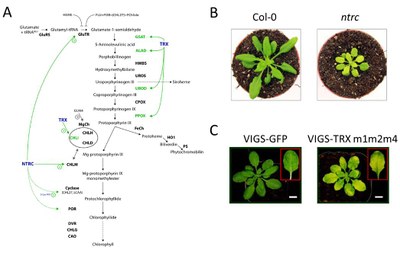Thiol-based redox control of tetrapyrrole biosynthesis in higher plants
Daniel Wittmann, Peng Wang, Andreas Richter
Thiol-based redox control is an essential post-translational regulatory mechanism, which leads to the modification of thiol groups in proteins. The redox status of thiol groups in proteins is important for the folding, stability, and catalytic activity of tightly controlled proteins and enzymes. Recent studies emphasize also the substantial control of multiple enzymes of tetrapyrrole biosynthesis including the subunit I of magnesium chelatase (CHLI) and magnesium protoporphyrin IX methyltransferase (CHLM) (Figure).
We intend to identify and characterize additional target enzymes of plastid redox control by using trx and ntrc mutant plants and TRX-affinity chromatography in combination with further protein-protein interaction analyses. We currently examine additional enzymes which have been earlier proposed as candidates for redox control, such as glutamyl-tRNA reductase (GluTR), 5-aminolevulinic acid dehydratase (ALAD), protoporphyrinogen IX oxidase (PPOX), protochlorophyllide oxidoreductase (POR), chlorophyll synthase (CHLG). The interaction of these enzymes with TRX variants and/or NTRC will be assessed by various methods, such as bimolecular fluorescence complementation assay, pull-down assay, yeast-two-hybrid assay, etc. Furthermore, the thiol groups of these enzymes, which are susceptible for redox-control, will be identified by site-directed mutagenesis (Cys → Ser). The impact of the redox status of these thiol groups on the stability, catalytic activity of enzymes will be investigated in vitro and in vivo with biochemical, genetic, physiological methods, i.a. by expression of substitution mutants in the endogenous knock-out mutant back ground.

A: Scheme of the tetrapyrrole biosynthetic pathway highlighting the enzymes which are proposed to be under the redox control via NTRC and/or thioredoxin (TRX). B and C: images of from Arabidopsis seedlings of the ntrc mutant and TRX m-silencing plants. The scheme was prepared by Andreas Richter, the photos were taken by Peng Wang.